| Plant |
Discussion |
Seasonal availability |
|
Anchusa
|
Very small, royal blue flowers with a neutral flavour. Their prettiness lends them to cupcakes and other sweet dishes, but they also complement many savoury courses. In cocktails, their colour will shine, or simply floated on top. |
November – March |
 |
Borage
|
Blue or white star-shaped flower with a mild cucumber taste. Can be added to all refreshing summer drinks, puddings and salads. They also excel in consommés, and other set dishes, as they are robust enough to hold their shape when refrigerated. |
October – March |
 |
Broad bean
|
Crimson, white, or black and white flowers with an intense fresh bean flavour. Can be eaten with bread and cheese or tossed through a green salad. |
October – December |
 |
Calendula
|
Bright orange or yellow petals. Can be scattered through salads, rice, cous cous, or atop cupcakes. Can be used as a flavour enhancement in soufflés, breakfast eggs, white sauces, soups and vinegars. The petals can also be simmered in milk and used as a saffron substitute. |
November – April |
 |
Chives
|
Purple globe flowers which can be separated into individual stars with a mild onion flavour. Perfect for garnishing soups, rice or risottos. |
November – February |
 |
Cornflower
|
Normally a bright-blue globe, but there are also pink, purple and white cornflowers. Neutral flavoured, the petals can be scattered on cakes or strewn through any salad, rice or risotto dish. |
December – March |
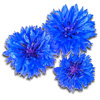 |
Dahlia
|
Vibrant and exotic flowers with no scent, and a mild nut flavour. Can be strewn on cakes. |
February – April |
 |
Dianthus
|
Pink flowers, with a clove-like scent. Can be used as a sweetish garnish on cakes or cupcakes. |
November – February |
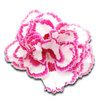 |
Electric daisy
|
Yellow seed heads which, when chewed, produce a tingly, numbing sensation on the lips. This effect goes particularly well with spirits, for example as a salt substitute on the rim of a margarita glass. |
December – April |
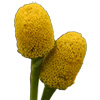 |
Garlic chives
|
Small star shaped white flowers. with a mild sweet garlic flavour. Can be used in salads or sprinkled over pizza or a hot crispy focaccia. |
March – April |
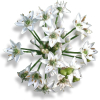 |
Green bean
(aka runner bean)
|
A variety of colours, from scarlet through to white, with a beany taste. They have a surprising crunch in the flower kernel. Use them in salads, in savoury dishes such as couscous, or as a flavoursome garnish for meat dishes. |
December – February |
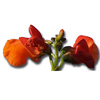 |
Leaf radish
|
The flower is similar in delicate form to its cousins the rocket flowers, but with pink and white versions available. Good for canapes, cocktails and savoury dishes. |
September – November |
 |
Mallow
|
Pink petals, with a deep pink heart. No need for sugar paste creations on cakes when nature does it so much better! |
December – March |
 |
Malope trifida
|
Deep magenta-pink flowers, with a vivid green eye at the centre. The petals look good scattered over sweet and savoury dishes. |
December – March |
 |
Marigold
(aka tagetes)
|
Robust, richly coloured, tasty petals. They keep extremely well, with a flower head lasting a week or more if kept in a cool dry environment. The savoury taste of the large petals makes them an ideal component in dolmades, where they retain their colour and bite. They can also be used as a garnish in savoury Asian and Indian cuisine. |
December – April |
 |
Mustard flower
|
Tiny bright yellow flowers clustered in heads, perfect for scattering over a plate or a cake. |
September – November |
 |
Nasturtium
|
A range of colours from yellows, through oranges, to deep reds and multi colour, with a distinctive sweet peppery taste when fresh. Eat whole or use the petals stripped and strewn over salads, risottos, savoury soups, etc. Or fry in a crispy tempura batter. |
January – April |
 |
Pea
|
White or pink, pea flowers, on their shoots if required, with the scent and flavour of fresh pea. Use them to provide a hit of fresh pea to complement any dish, from roast lamb with mint, to a mushroom risotto. |
October – December |
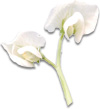 |
Pineapple sage
|
Crimson flowers, tubular in shape, with a flavour of pineapple. Use on cakes, cocktails or east-asian cuisine. |
March – April |
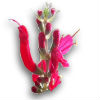 |
Primrose
|
Usually pale yellow flowers which look good on lemon cupcakes. Also available in stronger colours. |
September – November |
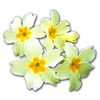 |
Primula gold lace
|
Deep to light burgundy red, edged with gold. Popular in drinks and cocktails, they are a robust little flower which also hold up well on cakes and scattered through rice or cous cous dishes. |
September – November |
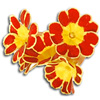 |
Rose
|
Highly scented. Use the petals in making jam or icing for cakes or as a cocktail ingredient. Also, use as a dressing for desserts, sorbets and pastries. |
December – March |
 |
Salad rocket
|
Delicate white veined flowers with a peppery rocket taste. Can be used as a compliment to savoury dishes, or scattered over focaccia or pizza. |
September – April |
 |
Scented geranium
|
Delicate flowers with a wide range of aromas. Their strong perfume works well when making jam, preserves and sweet delicacies. |
December – March |
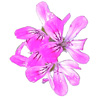 |
Shungiku
(aka edible chrysanthemum)
|
Yellow and white petals with a slight peppery after taste. Can be strewn across both sweet and savoury dishes. |
October – February |
 |
Sunflower
|
A large-scale plant, with firm, buttery nut-flavoured petals, similar to small salad leaves in size. Sunflowers come in many colours, from yellow, through oranges, to deep burnt red-browns. Use them in all kinds of summer dishes, such as salads, risotto, fresh fish, potato salad, and carrot cakes. |
February – April |
 |
Tulip
|
The spectrum of tulip colours and striping is well known, but perhaps more surprising is the range of flavours, from lettuce-like to rocket-like. |
November – December |
 |
Viola
|
Available in a range of colours, with generally two tones per flower. Use as a sweet adornment, particularly on wedding cakes, cupcakes or chocolate desserts. Can also be added to either hot or cold drinks. |
September – May |
 |
Wild rocket
|
Small delicate yellow flowers, with a peppery rocket taste. Can be used as a compliment to savoury dishes, or scattered over focaccia or pizza. |
December – April |
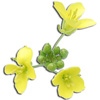 |
Zucchini
(aka courgette)
|
Large, yellow flowers. Traditionally stuffed, or dipped in tempura batter and deep fried – the ultimate antipasti. |
December – February |
 |































I notice there is no mention of dandelions in the list. There are so many popping up around Eltham at the moment. Young and fresh.
I blanch for three minutes, then chop and mix with silverbeet and make spanakopita.
Cheers
Yvonne
Can pumpkin flowers be eaten?
Yes. And you can eat them raw or cooked.